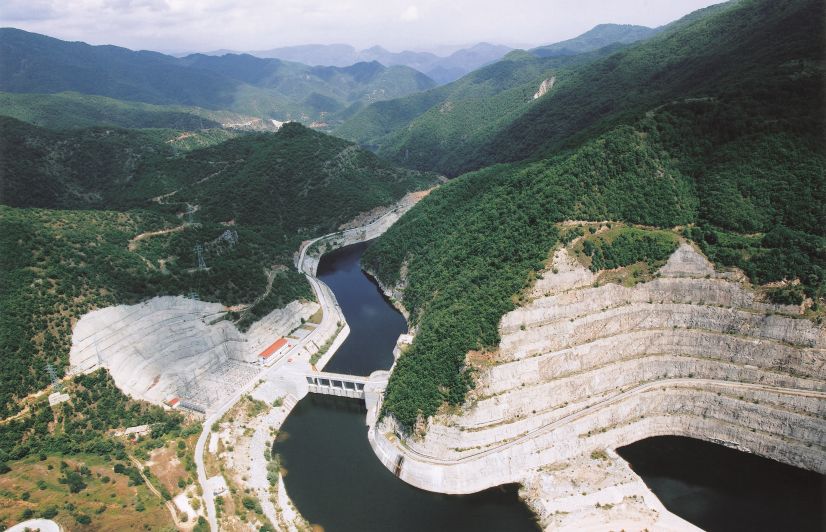It should therefore be managed in a rational way in order to meet needs in the best and most efficient way.
Greece is a mostly mountainous country (over 80%), with most of its mountains located on its northwestern part of the country, which, for the most part, lends itself to hydropower development.
- Its annual theoretical hydropower potential amounts to approximately: 80 Twh.
- The economically exploitable hydropower potential amounts to: 12 Twh.
- To date, approximately: 40% of the total potential has been developed.
Background
-
The development of the Hydropower potential in Greece essentially coincides with the establishment of PPC Public Power Corporation in 1950.
-
Prior to the establishment of PPC (1950), very small Hydroelectric Plants had been put into operation in the period 1927–1931 (Glafkos, Vermio, Almyros in Chania), with a total installed capacity of 5.8 MW.
-
During the period 1950–1975, seven (7) large Hydroelectric Power Plants (Agra, Ladonas, N. Plastiras, Kremasta, Kastraki, Edessaios and Polyfytos) and one (1) small HPP (Louros), with total installed capacity 1,411.4 MW, were constructed. These include the three (3) largest HPPs: Kremasta, Kastraki, Polyfytos.
-
In the period 1976 – to date, nine (9) large and five (5) small HPPs (Pournari I and II, Sfikia, Asomata, Stratos I, SHPP Stratos II, Pighai Aoos, Thisavros, Platanovrysi, SHPP Ghiona, SHPP Makrochori, SHPP Ag. Barbara, Ilarion, SHPP Ilarion), with a total installed capacity of 1,800.2 MW were constructed. These also include two Pumped-storage Power Plants (Sfykia, Thisavros).
-
Two (2) large Hydropower Plants with a total capacity of 200 MW (Messochora, Metsovitiko) are currently under construction and are scheduled to be commissioned within the next three years.
The Hydroelectric Power Plants today - Organization
The total installed capacity of the Hydroelectric Power Plants (HPPs and SHPPs) of PPC SA amounts to 3,217.4 MW.
The average annual hydroelectric generation from HPPs is approximately 4,020 Gwh (average 5 years) and depending on the hydraulicity of the year covers 8 ÷ 10% of the total energy generation of PPC S.A.
In particular, for 2020 the Hydroelectric Generation amounted to 5,282 Gwh.
Large Hydroelectric Power Plants (HPP's)
The sixteen (16) in total large Hydroelectric Power Plants (HPPs with installed capacity> 15 MW) are mainly part of four (4) Complexes and two (2) Independent HPPs, with a total installed capacity of 3,170.7 MW.
Acheloos Complex: (Kremasta, Kastraki, Stratos I).
-
Acheloos river, Prefecture of Aitoloakarnania, Western Greece.
-
Total Installed Capacity: 907.2 MW
Aliakmonas Complex: (Ilarion, Polyfytos, Sfikia, Asomata / Agra, Edessaios).
- Aliakmonas river, Prefecture of Kozani / Imathia, Western/Central Macedonia / Edessaios river, Prefecture of Pella, Central Macedonia.
-
Total Installed Capacity: 1,020 MW
Arachthos Complex: (Pighai Aoos, Pournari I, Pournari II).
-
Aoos river / Arachthos, Prefecture of Ioannina / Arta, Epirus.
-
Total Installed Capacity: 543.6 MW
Nestos river Complex: (Thisavros, Platanovrysi).
-
Nestos river, Prefecture of Drama, Eastern Macedonia.
-
Total Installed Capacity: 500 MW
N. Plastiras
-
Tavropos river, Prefecture of Karditsa, Thessalia
-
Installed Capacity: 129.9 MW
Ladonas
-
Ladonas river, Prefecture of Arcadia, Peloponnese.
-
Installed Capacity: 70 MW
At the same time, PPC Renewables currently has 18 Small Hydroelectric Power Plants in operation, 4 in the construction phase and several new projects have been granted a generation license. Electricity generation in 2020 amounted to 136 GWh, while through the operation of the HPPs the emission of 94,108 tonnes of CO2 was avoided and the energy needs of 37,104 Greek households were covered.
Within 2021, the construction of the Small Hydroelectric Power Project (SHPP) Smokovo II (3.2 MW) is to be completed.
HPP's as multipurpose facilities
Energy generation
Hydroelectric Power Plants contribute more than 9% to the total generation of PPC SA. The energy generated is "green - clean", in other words it is not polluting and is of high quality, i.e. covers peak loads and has high flexibility in its integration.
Ancillary services
Due to their special characteristics, HPPs provide ancillary services to the Power System, i.e. power reserve, regulation of frequency, voltage, etc.
Flood protection
The main river reservoirs with their storage capacity prevent flood phenomena from occurring by providing flood protection at the downstream areas of HPPs.
Irrigations
About 5000,000 stremma are irrigated from the reservoirs of the HPPs, thus contributing to the agricultural production of the country.
Water Supply
The populations of many cities are supplied with water from the reservoirs of the HPPs (e.g. Thessaloniki, Karditsa, Agrinio, Arta, etc.).
Water Sports
Many lakes where HPPs are located are used for water sports activities, such as water skiing, rowing, kayaking, etc. (Lake Stratos, Lake Polyfytos, etc.).
Fishing
Fishing, both for professionals and amateurs, is one of the many activities that take place in the reservoirs of the HPPs which have clean water enriched with spawn by PPC.
Recreational activities
The shores of lakes are ideal locations for the creation of recreational and tourism activities. Typical examples are the lake of Pighai Aoos, the beach of Lamberou in the Lake Plastiras, etc.
Environmental upgrade
In general, the HPPs enhance their environment by creating ecosystems in the area of the lakes and by maintaining within the riverbeds the ecological benefits for the preservation of fish fauna.
